Dynamic Accounting Model and Method for Carbon Emissions on the Power Grid Side
Abstract
:1. Introduction
2. QIO Model for Nodes in the Grid
3. Dynamic Accounting Method for Carbon Emissions on the Grid Side
3.1. Electric Energy Metering Network
3.2. Dynamic Carbon Emission Accounting Method on the Grid Side
4. Case Validation
5. Discussion and Conclusion
- (1)
- Uncertainty analysis
- (2)
- The carbon EFs, the amount of carbon emissions generated by the internal losses of the nodes, and the carbon emissions flowing out of the nodes can be calculated over time using the electric metering data, taking the nodes as accounting boundaries such as transmission lines, substations, and distribution sides. The accounting method is simple and clear.
- (3)
- This accounting model is dynamic in the spatiotemporal dimensions, as it covers all the nodes on the power grid side in the spatial dimension and shares the same time resolution with the electric energy measurement data in the temporal dimension.
- (4)
- Next, we will rely on the electricity metering platform of Southern Power Grid and select a small power grid for carbon emission accounting, providing experience for future promotion across the entire network.
Author Contributions
Funding
Data Availability Statement
Acknowledgments
Conflicts of Interest
References
- Nabavi, S.A.; Motlagh, N.H.; Zaidan, M.A.; Aslani, A.; Zakeri, B. Deep learning in energy modeling: Application in smart buildings with distributed energy generation. IEEE Access 2021, 9, 125439–125461. [Google Scholar] [CrossRef]
- Li, Y.; Zhang, N.; Du, E.; Liu, Y.; Cai, X.; He, D. Research and Benefit Analysis of Low-carbon Demand Response Mechanism in Power System Based on Carbon Emission Flow. Chin. J. Electr. Eng. 2022, 42, 2830–2842. [Google Scholar]
- Kopsakangas-Savolainen, M.; Mattinen, M.K.; Manninen, K.; Nissinen, A. Hourly-based greenhouse gas emissions of electricity-cases demonstrating possibilities for households and companies to de-crease their emissions. J. Clean. Prod. 2017, 153, 384–396. [Google Scholar] [CrossRef]
- Li, Y.; Zhang, N.; Du, E.; Liu, Y. Mechanism study and benefit analysis on power system low carbon demand response based on carbon emission flow. Proc. CSEE 2022, 42, 2830–2842. [Google Scholar]
- Eggleston, H.S.; Buendia, L.; Miwa, K.; Ngara, T.; Tanabe, K. 2006 IPCC Guidelines for National Greenhouse Gas Inventories; IPCC National Greenhouse Gas Inventories Programme: Geneva, Switzerland, 2006. [Google Scholar]
- Miller, G.J.; Novan, K.; Jenn, A. Hourly accounting of carbon emissions from electricity consumption. Environ. Res. Lett. 2022, 17, 044073. [Google Scholar] [CrossRef]
- Duan, S.; Chen, H.; Zheng, X.; Huang, J.; Deng, S. Bidding strategy of electricity generation and electricity market equilibrium analysis under the background of carbon market. Electr. Meas. Instrum. 2022, 59, 33–41. [Google Scholar]
- Tranberg, B.; Corradi, O.; Lajoie, B.; Gibon, T.; Staffell, I.; Andresen, G.B. Real-time carbon accounting method for the European electricity markets. Energy Strategy Rev. 2019, 26, 100367. [Google Scholar] [CrossRef]
- Clauß, J.; Stinner, S.; Solli, C.; Lindberg, K.B.; Madsen, H.; Georges, L. Evaluation Method for the Hourly Average CO2eq. Intensity of the Electricity Mix and Its Application to the Demand Response of Residential Heating. Energies 2019, 12, 1345. [Google Scholar] [CrossRef] [Green Version]
- Zhou, T.; Kang, C.; Xu, Q. Preliminary Theoretical Investigation on Power System Carbon Emission Flow. Autom. Power System. 2012, 36, 38–44. [Google Scholar]
- Kang, C.; Cheng, Y.; Sun, Y. Recursive Calculation Method of Carbon Emission Flow in Power Systems. Autom. Power Syst. 2017, 41, 10–16. [Google Scholar]
- Chen, D.; Xian, W.; Wu, T. Allocation of Carbon Emission Flow in Hybrid Electricity Market. Power Syst. Technol. 2016, 40, 1683–1688. [Google Scholar]
- Minx, J.C.; Wiedmann, T.; Wood, R.; Peters, G.P.; Lenzen, M.; Owen, A.; Scott, K.; Barrett, J.; Hubacek, K.; Baiocchi, G.; et al. Input−output analysis and carbon footprinting: An overview of applications. Econ. Syst. Res. 2009, 21, 187–216. [Google Scholar] [CrossRef]
- Leontief, W.; Ford, D. Air pollution and the economic structure: Empirical results of input−output calculations. In Proceedings of the Fifth International Conference on Input−Output Techniques; North Holland Pub. Co.: Geneva, Switzerland, 1971. [Google Scholar]
- Praseeda, K.I.; Reddy, B.V.V.; Mani, M. Embodied energy assessment of building materials in India using process and input−output analysis. Energy Build. 2015, 86, 677–686. [Google Scholar] [CrossRef]
- Chen, G.; Guo, S.; Shao, L.; Li, J.; Chen, Z.-M. Three-scale input−output modeling for urban economy: Carbon emission by Beijing 2007. Commun. Nonlinear Sci. Numer. Simul. 2013, 18, 2493–2506. [Google Scholar] [CrossRef]
- Su, B.; Ang, B.W. Input−output analysis of CO2 emissions embodied in trade: A multi-region model for China. Appl. Energy 2014, 114, 377–384. [Google Scholar] [CrossRef]
- Machado, G.; Schaeffer, R.; Worrell, E. Energy and carbon embodied in the international trade of Brazil: An input−output approach. Ecol. Econ. 2001, 39, 409–424. [Google Scholar] [CrossRef]
- Qu, S.; Wang, H.; Liang, S.; Shapiro, A.M.; Suh, S.; Sheldon, S.; Zik, O.; Fang, H.; Xu, M. A Quasi-Input-Output model to improve the estimation of emission factors for purchased electricity from interconnected grids. Appl. Energy 2017, 200, 249–259. [Google Scholar] [CrossRef]
- Kanemoto, K.; Moran, D.; Hertwich, E.G. Mapping the carbon footprint of nations. Environ. Sci. Technol. 2016, 50, 10512–10517. [Google Scholar] [CrossRef]
- Tukker, A.; Bulavskaya, T.; Giljum, S.; De Koning, A.; Lutter, S.; Simas, M.; Stadler, K.; Wood, R. The global resource footprint of nations. Carbon, water, land and materials embodied in trade and final consumption. In A Publication of the Compiling and Refining of Economic and Environmental Accounts Project; The Netherlands Organization for Applied Scientific Research – NL-2628 XE Delft; Leiden University: Leiden, The Netherlands, 2014. [Google Scholar]
- Chen, S.; Chen, B. Tracking inter-regional carbon flows: A hybrid network model. Environ. Sci. Technol. 2016, 50, 4731–4741. [Google Scholar] [CrossRef]
- Kodra, E.; Sheldon, S.; Dolen, R.; Zik, O. The North American electric grid as an exchange network: An approach for evaluating energy resource composition and greenhouse gas mitigation. Environ. Sci. Technol. 2015, 49, 13692–13698. [Google Scholar] [CrossRef]
- Huang, N.; Wang, H.T.; Fan, C.D.; Zhou, S.C.; Hou, P.; Yang, J. LCA data quality assessment and control based on uncertainty and sensitivity analysis. Acta Sci. Circumstantiae 2012, 32, 1529–1536. [Google Scholar]
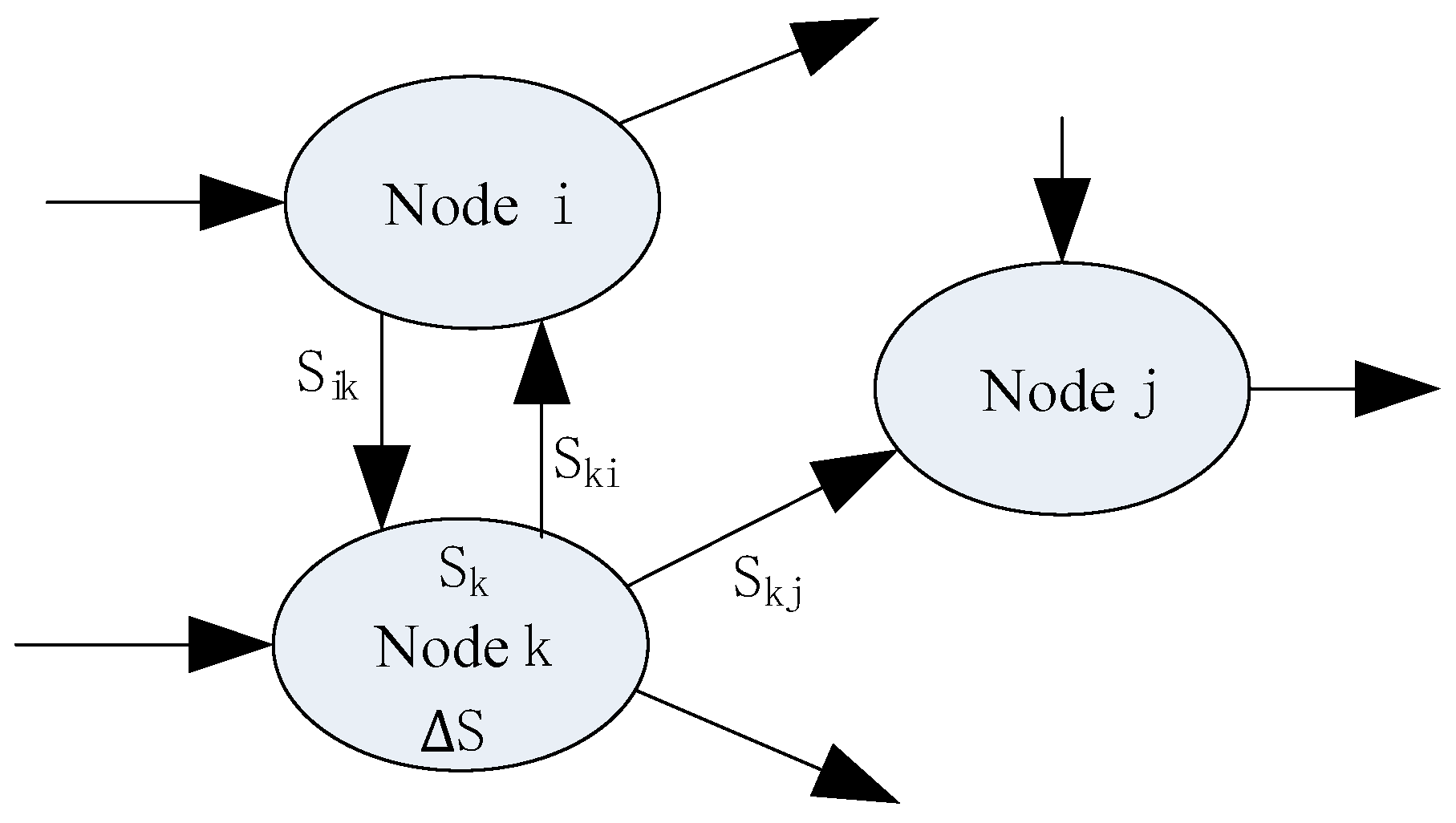
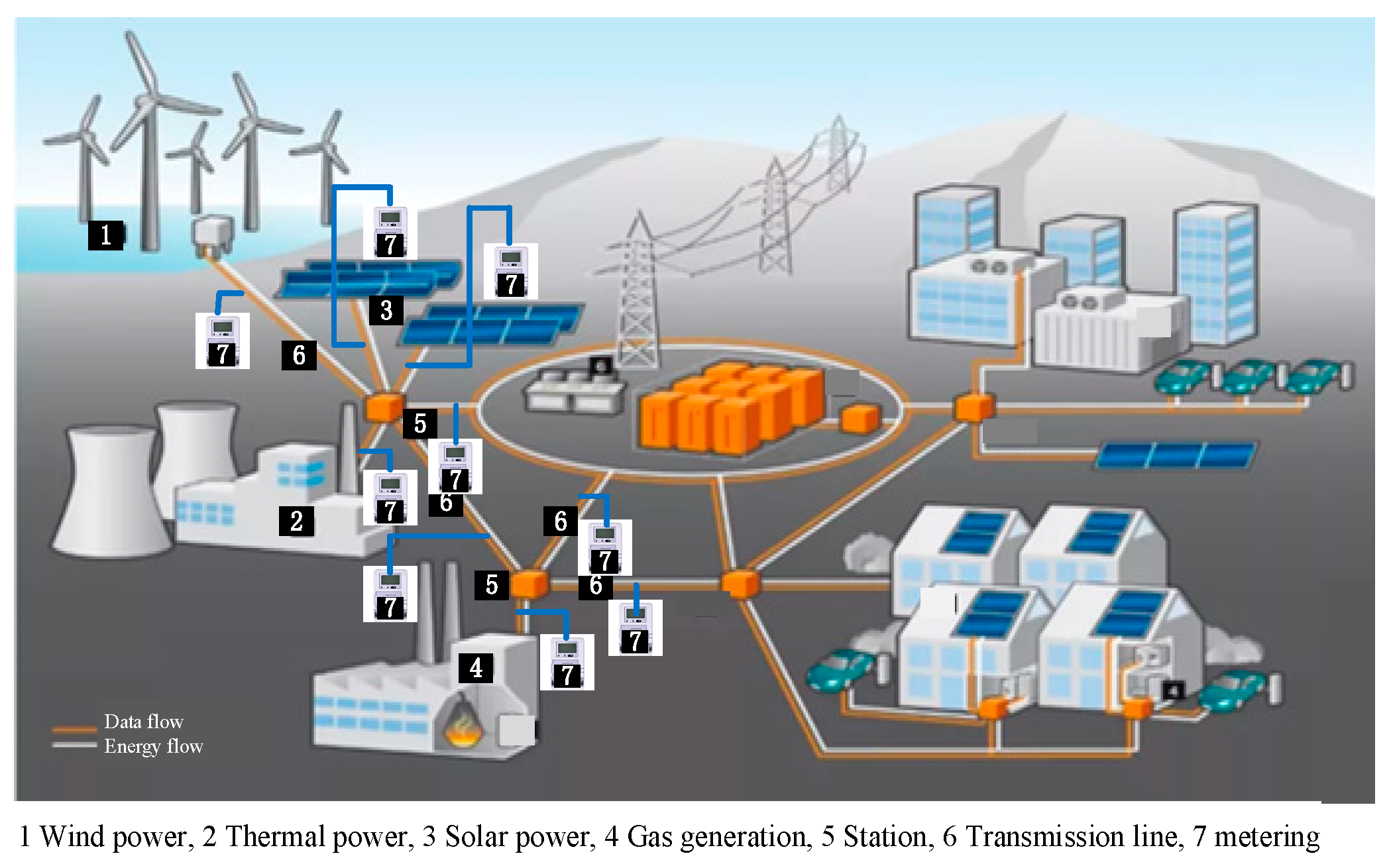

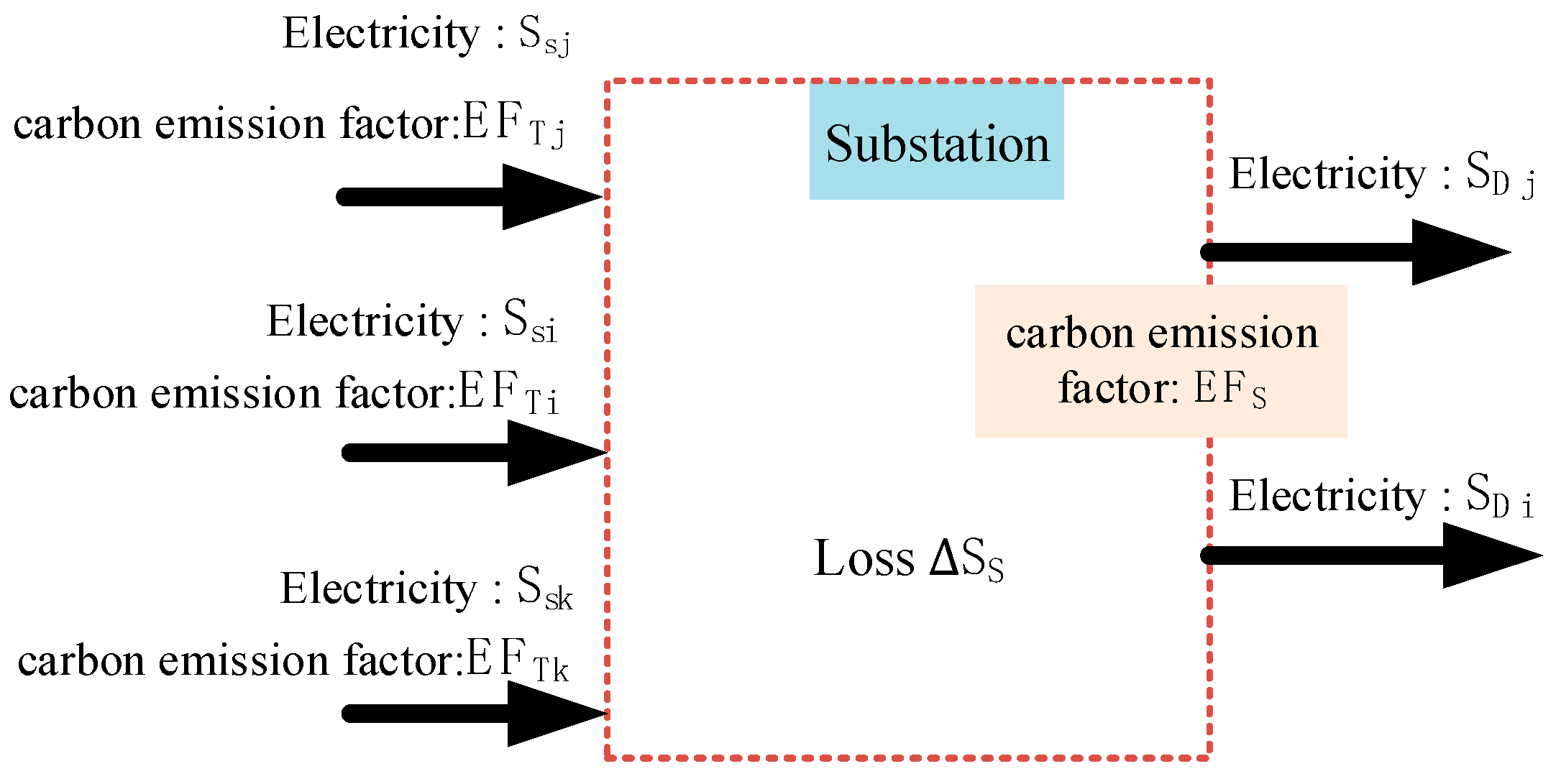

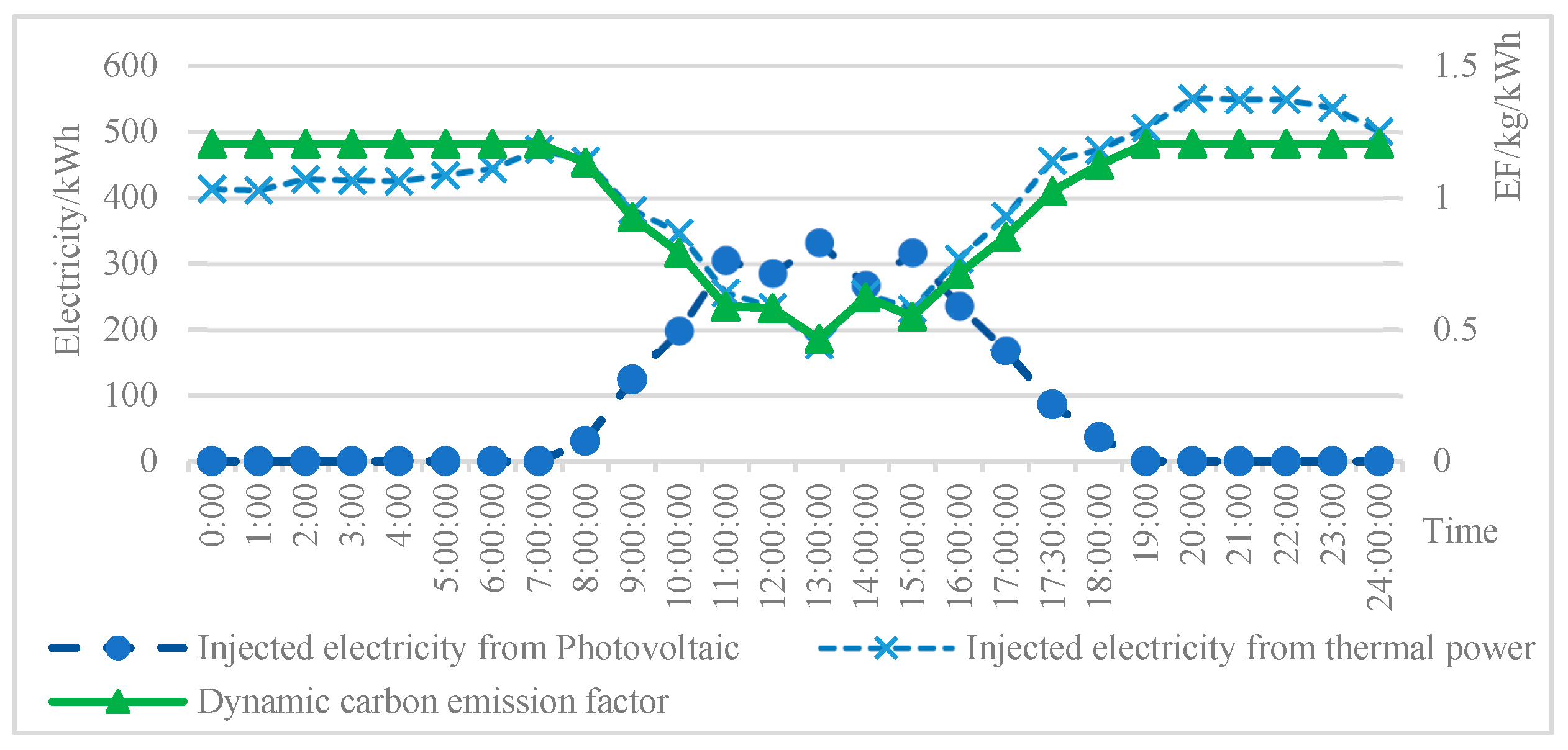

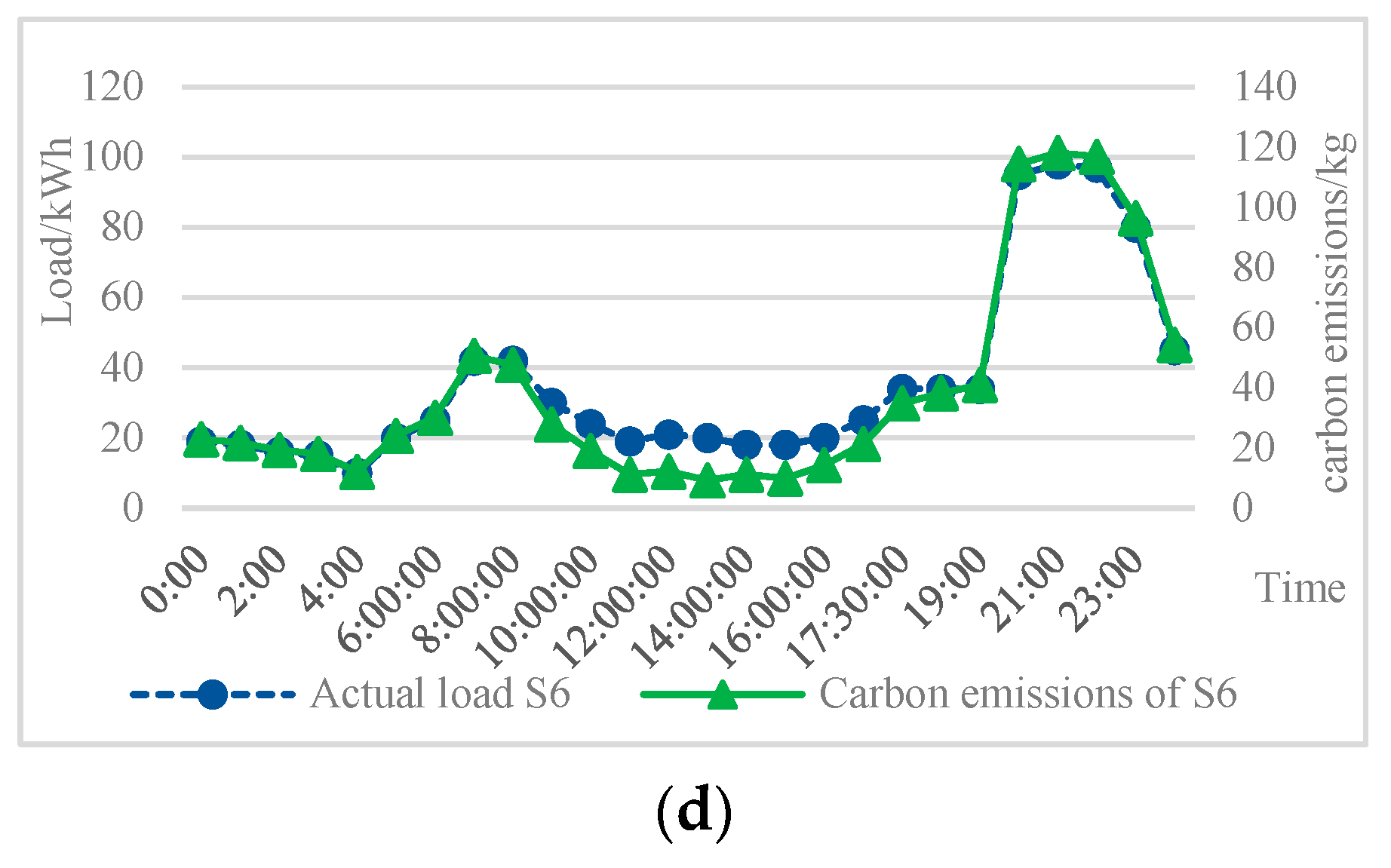
| Time | S1/kWh | S2/kWh | S3/kWh | S4/kWh | S5/kWh | S6/kWh |
|---|---|---|---|---|---|---|
| 0:00 | 0.00 | 413.38 | 390.00 | 17.16 | 0.00 | 19.00 |
| 1:00 | 0.00 | 411.55 | 390.00 | 16.28 | 0.00 | 18.00 |
| 2:00 | 0.00 | 428.16 | 410.00 | 15.40 | 0.00 | 16.00 |
| 3:00 | 0.00 | 426.33 | 410.00 | 14.52 | 0.00 | 15.00 |
| 4:00 | 0.00 | 425.05 | 415.00 | 13.20 | 0.00 | 10.00 |
| 5:00 | 0.00 | 434.33 | 415.00 | 12.76 | 0.00 | 20.00 |
| 6:00 | 0.00 | 444.03 | 420.00 | 12.76 | 0.00 | 25.00 |
| 7:00 | 0.00 | 473.13 | 425.00 | 12.76 | 8.00 | 42.00 |
| 8:00 | 30.80 | 456.52 | 430.00 | 15.84 | 13.60 | 42.00 |
| 9:00 | 124.20 | 381.48 | 440.00 | 27.28 | 20.20 | 30.00 |
| 10:00 | 198.60 | 347.22 | 470.00 | 43.56 | 19.00 | 24.00 |
| 11:00 | 305.60 | 255.65 | 490.00 | 41.36 | 18.80 | 19.00 |
| 12:00 | 285.60 | 233.96 | 450.00 | 41.80 | 14.00 | 21.00 |
| 13:00 | 332.40 | 176.97 | 430.00 | 44.44 | 20.40 | 20.00 |
| 14:00 | 267.90 | 254.12 | 450.00 | 42.68 | 19.20 | 18.00 |
| 15:00 | 317.30 | 231.46 | 480.00 | 38.72 | 19.20 | 18.00 |
| 16:00 | 236.40 | 307.61 | 480.00 | 34.32 | 19.20 | 20.00 |
| 17:00 | 168.30 | 371.84 | 480.00 | 29.04 | 17.60 | 25.00 |
| 18:00 | 36.40 | 472.51 | 450.00 | 25.52 | 14.00 | 34.00 |
| 19:00 | 0.00 | 506.11 | 450.00 | 23.76 | 14.00 | 34.00 |
| 20:00 | 0.00 | 550.73 | 440.00 | 23.76 | 9.00 | 95.00 |
| 21:00 | 0.00 | 548.75 | 440.00 | 27.72 | 0.00 | 98.00 |
| 22:00 | 0.00 | 548.63 | 440.00 | 28.60 | 0.00 | 97.00 |
| 23:00 | 0.00 | 536.29 | 450.00 | 22.88 | 0.00 | 80.00 |
| Type of Electricity | LCA Carbon Emission Factors/kg/kWh |
|---|---|
| Coal-fired power generation | 1.205 |
| Natural gas power generation | 0.451 5 |
| Hydropower | 0.003 5 |
| Photovoltaics | 0.070 4 |
Disclaimer/Publisher’s Note: The statements, opinions and data contained in all publications are solely those of the individual author(s) and contributor(s) and not of MDPI and/or the editor(s). MDPI and/or the editor(s) disclaim responsibility for any injury to people or property resulting from any ideas, methods, instructions or products referred to in the content. |
© 2023 by the authors. Licensee MDPI, Basel, Switzerland. This article is an open access article distributed under the terms and conditions of the Creative Commons Attribution (CC BY) license (https://creativecommons.org/licenses/by/4.0/).
Share and Cite
He, H.; Zhou, S.; Zhang, L.; Zhao, W.; Xiao, X. Dynamic Accounting Model and Method for Carbon Emissions on the Power Grid Side. Energies 2023, 16, 5016. https://doi.org/10.3390/en16135016
He H, Zhou S, Zhang L, Zhao W, Xiao X. Dynamic Accounting Model and Method for Carbon Emissions on the Power Grid Side. Energies. 2023; 16(13):5016. https://doi.org/10.3390/en16135016
Chicago/Turabian StyleHe, Hengjing, Shangli Zhou, Leping Zhang, Wei Zhao, and Xia Xiao. 2023. "Dynamic Accounting Model and Method for Carbon Emissions on the Power Grid Side" Energies 16, no. 13: 5016. https://doi.org/10.3390/en16135016
APA StyleHe, H., Zhou, S., Zhang, L., Zhao, W., & Xiao, X. (2023). Dynamic Accounting Model and Method for Carbon Emissions on the Power Grid Side. Energies, 16(13), 5016. https://doi.org/10.3390/en16135016






